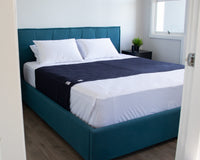What causes incontinence?
If the muscles and nerves associated with the urinary tract and the release region that holds urine and then passes urine are weak and lacking in muscular support, this can more commonly lead to what is known as incontinence.
Incontinence is the lack of a person’s ability to control leakage of urine and or faeces and or flatulence.
If the pelvic floor is weakened the common symptom is often loss of bladder control. This is not just in the passing of urine. It can also affect the passage of wind and/or faeces.
Detecting if a person has an overactive bladder is often due to symptoms which include frequent urges to urinate and frequently waking-up during the night to urinate. The common causes can include weak pelvic floor muscles, nerve damage, use of medications, alcohol or caffeine, infection and being overweight or obese.
This can be mitigated with health and lifestyle changes.
Urinary incontinence is usually caused by issues with muscles and nerves problems that would normally hold or pass urine.
For women, pregnancy, childbirth, and menopause, can cause weakening associated muscles and nerves which can then lead to urinary incontinence issues.
It’s a topic some people find hard to talk about or shy away from seeking help and advice.
What is incontinence?
Basically, continence is the ability to control your bladder and/or your bowel. Incontinence is the inability to control your bladder and or your bowel.
Incontinence is the involuntary loss of bladder and bowel control, that is urination and defecation.
What does incontinence mean?
Incontinence describes any accidental or involuntary loss of urine from the bladder, known as urinary incontinence.
(Incontinence is also more commonly referred to as wee)
The description of incontinence can also be used to include faeces (poo) or flatus (wind) from the bowel. This is often referred to as faecal incontinence.
Incontinence means a person is unable to control the evacuative functions of urination or defecation, whether it be partial or complete loss of bladder or bowel control leading to urinary incontinence and or faecal incontinence.
What are the 4 types of incontinence?
The 4 most common types of incontinence are:
What is stress incontinence?
Stress incontinence is when urine leaks as a result of exerting pressure on your bladder or when your bladder is under pressure caused by normal movement, coughing, sneezing, laughing, exercising, gym activity, playing sport, walking or running, or lifting anything heavy.
According to Harvard Medical School, Types of urinary incontinence, published December 2014 …
“Stress incontinence occurs when the urethral sphincter, the pelvic floor muscles, or both these structures have been weakened or damaged and cannot dependably hold in urine. Stress incontinence is divided into two subtypes. In urethral hypermobility, the bladder and urethra shift downward when abdominal pressure rises, and there is no hammock-like support for the urethra to be compressed against to keep it closed. In intrinsic sphincter deficiency, problems in the urinary sphincter interfere with full closure or allow the sphincter to pop open under pressure. Many experts believe that women who have delivered vaginally are most likely to develop stress incontinence because giving birth has stretched and possibly damaged the pelvic floor muscles and nerves. Generally, the larger the baby, the longer the labour, the older the mother, and the greater the number of births, the more likely that incontinence will result.
Age is likewise a factor in stress incontinence. As a woman gets older, the muscles in her pelvic floor and urethra weaken, and it takes less pressure for the urethra to open and allow leakage. Estrogen can also play some role, although it is not clear how much. Many women do not experience symptoms until after menopause.
In men, the most frequent cause of stress incontinence is urinary sphincter damage sustained through prostate surgery or a pelvic fracture.
Lung conditions that cause frequent coughing, such as emphysema and cystic fibrosis, can also contribute to stress incontinence in both men and women.”
Urge incontinence / Overactive bladder / Hyperactive incontinence
Urge incontinence is the involuntary loss of urine (wee) associated with urgency (a sudden and strong need to urinate).
In a normal bladder, usually when the bladder is about half full, you’ll feel the need to go to the toilet.
A healthy bladder can usually hold up to about 600mls of urine. Also, with a healthy bladder, most people can then hold on after the initial feeling until it’s convenient to go to the toilet.
If a person has urge incontinence, they can get a strong feeling to urinate even when the bladder is nowhere near full.
This can occur in both men and women. The feeling of needing to urinate can often result in the expelling of urine before reaching the toilet. Urge incontinence can result in the feeling of needing to urinate more frequently.
Whether it’s accidental, or a feeling of urgency or the frequent feeling to relieve yourself, can interfere with everyday activities because of the need to keep going to the toilet.
What causes urge incontinence?
Urge incontinence tends to become more apparent as a person gets older in age. Symptomatic stress can also worsen after drinking fluids like tea, coffee, fizzy drinks or alcohol.
Health conditions prone to urge incontinence can be associated with victims of stroke, Parkinson’s disease, multiple sclerosis and other health affected conditions and medical diagnosis.
Stroke, Parkinson's disease and multiple sclerosis and other similar health conditions that interfere with the brain’s ability to send messages to the bladder via the spinal cord can be linked to urge incontinence. Resulting in a person’s inability to hold and retain urine.
Constipation, an enlarged prostate gland, or even after a long history of poor bladder control and bladder behaviour may lead to causing the bladder to become overactive.
Options on how to best manage urge incontinence
The main aim of managing urge incontinence is to improve bladder control.
Some options may include:
- Trying to resist the strong urge sensation when safe and where possible
By resisting, hoping to slowly increase the storage capacity or size of your bladder
- Trying to increase the period of time between visits to the toilet.
Other tips include:
- Keeping a bladder diary or taking note, may help you identify your pattern of how many times a day you pass urine and when accidental leakage occurs
- Keeping records could be useful when seeing or discussing incontinence with your doctor
- Your doctor may prescribe specific medication to help relax the bladder muscle and improve retention of urine
- A bladder training and exercise program can improve bladder control.
- Pelvic floor exercises can assist in helping to improve poor and weak bladder muscles. As pelvic floor muscles become stronger and healthier, you will then notice a reduction in the feeling of urgency and the ability to hold your urine in your bladder longer.
According to Harvard Medical School, Types of urinary incontinence, published December 2014 …
Overactive bladder / Urge incontinence
“If you feel a strong urge to urinate even when your bladder isn't full, your incontinence might be related to overactive bladder, sometimes called urge incontinence. This condition occurs in both men and women and involves an overwhelming urge to urinate immediately, frequently followed by loss of urine before you can reach a bathroom. Even if you never have an accident, urgency and urinary frequency can interfere with work and a social life because of the need to keep running to the bathroom.
Urgency is caused when the bladder muscle, the detrusor, begins to contract and signals a need to urinate, even when the bladder is not full. Another name for this phenomenon is detrusor overactivity.
Overactive bladder can result from physical problems that keep your body from halting involuntary bladder muscle contractions. Such problems include damage to the brain, the spine, or the nerves extending from the spine to the bladder — for example, from an accident, diabetes, or neurological disease. Irritating substances within the bladder, such as those produced during an infection, might also cause the bladder muscle to contract.
Often there is no identifiable cause for overactive bladder, but people are more likely to develop the problem as they age. Postmenopausal women, in particular, tend to develop this condition, perhaps because of age-related changes in the bladder lining and muscle. African American women with incontinence are more likely to report symptoms of overactive bladder than stress incontinence, while the reverse is true in white women.
A condition called myofascial pelvic pain syndrome has been identified with symptoms that include overactive bladder accompanied by pain in the pelvic area or a sense of aching, heaviness, or burning.
In addition, infections of the urinary tract, bladder, or prostate can cause temporary urgency. Partial blockage of the urinary tract by a bladder stone, a tumour (rarely), or, in men, an enlarged prostate (a condition known as benign prostatic hyperplasia, or BPH) can cause urgency, frequency, and sometimes
urge incontinence. Surgery for prostate cancer or BPH can trigger symptoms of overactive bladder, as can freezing (cryotherapy) and radiation seed treatment (brachytherapy) for prostate cancer.
Neurological diseases (such as Parkinson's disease and multiple sclerosis) can also result in urge incontinence, as can a stroke. When hospitalized following a stroke, 40% to 60% of patients have incontinence; by the time they are discharged, 25% still have it, and one year later, 15% do.”
Overflow incontinence
People who have an overflow incontinence condition can non-voluntarily leak urine whilst sitting or lying down without any added pressure like coughing or any particular movement involved etc.
According to Harvard Medical School, Types of urinary incontinence, published December 2014 …
“If your bladder never completely empties, you might experience urine leakage, with or without feeling a need to go. Overflow incontinence occurs when something blocks urine from flowing normally out of the bladder, as in the case of prostate enlargement that partially closes off the urethra. It can also occur in both men and women if the bladder muscle becomes underactive (the opposite of an overactive bladder) so you don't feel an urge to urinate. Eventually the bladder becomes overfilled, or distended, pulling the urethra open and allowing urine to leak out. The bladder might also spasm at random times, causing leakage. This condition is sometimes related to diabetes or cardiovascular disease.
Men are much more frequently diagnosed with overflow incontinence than women because it is often caused by prostate-related conditions. In addition to enlarged prostate, other possible causes of urine blockage include tumors, bladder stones, or scar tissue. If a woman has severe prolapse of her uterus or bladder (meaning that the organ has dropped out of its proper position), her urethra can become kinked like a bent garden hose, interfering with the flow of urine.
Nerve damage (from injuries, childbirth, past surgeries, or diseases such as diabetes, multiple sclerosis, or shingles) and aging often prevent the bladder muscle from contracting normally. Medications that prevent bladder muscle contraction or that make you unaware of the urge to urinate can also result in overflow incontinence.”
Mixed Incontinence
Mixed incontinence is usually the combination of both overactive bladder/overflow incontinence and stress incontinence.
Most women with incontinence have a combination of stress and urge symptoms which can be quite challenging at times.
For men with mixed incontinence, it can usually be the result of having had prostate removal surgery for an enlarged prostate.
Mixed incontinence is quite common in frail and elderly people both male and female.
2 other forms of incontinence could include:
- Functional incontinence
- Reflex incontinence
How do you fix incontinence?
For many people with urinary incontinence, the following self-help tips and lifestyle changes are enough to relieve symptoms.
- Do daily pelvic floor exercises
- Do not smoke
- Do the right pelvic floor exercises
- Avoid lifting in particular heavy goods or weights
- Lose any excess weight
- Treat constipation promptly
- Cut down on caffeine
- Cut down on alcohol
NIGHT N DAY is a registered NDIS provider.
----------------------------------------------------------------------------------------------
Should you require any product assistance … Did you know that we manufacture a complete range of incontinence products including absorbent underwear and waterproof pads? Some of these products also double as period-proof underwear.
We're with you Night n Day
If you have any questions about incontinence or want to know what incontinence products are the best for you or your loved one don’t hesitate to contact our friendly Customer Service team
- THERE’S NO SUCH THING AS A SILLY QUESTION!
----------------------------------------------------------------------------------------------
Email: gday@nightnday.com.au
Australia: (02) 9531 2011
International: +61 2 9531 2011
P: +61 2 9531 2011
Disclaimer: No content on this website, or in this article, regardless of date, should ever be used as a substitute for direct medical advice from your doctor or other qualified clinician.







